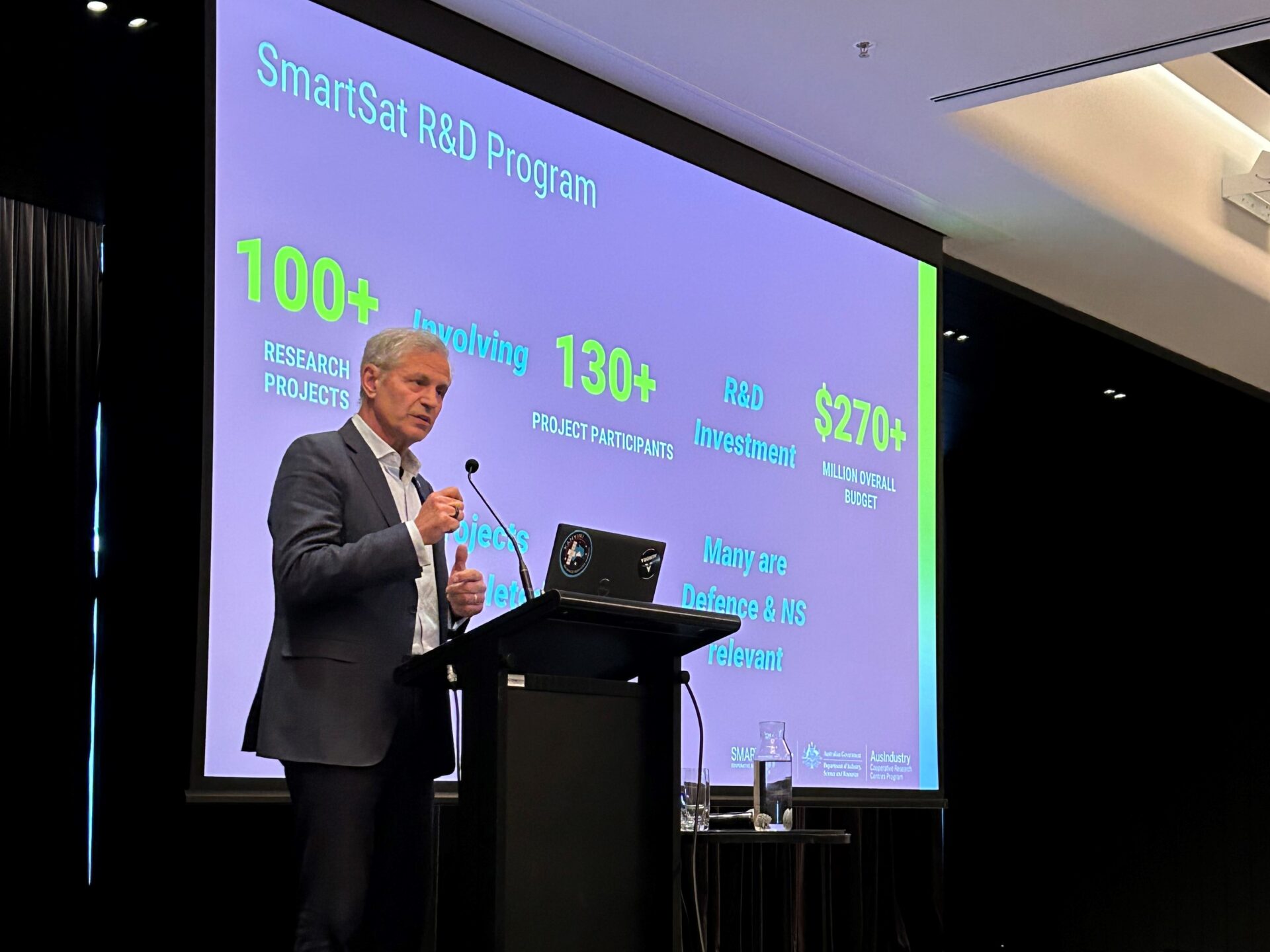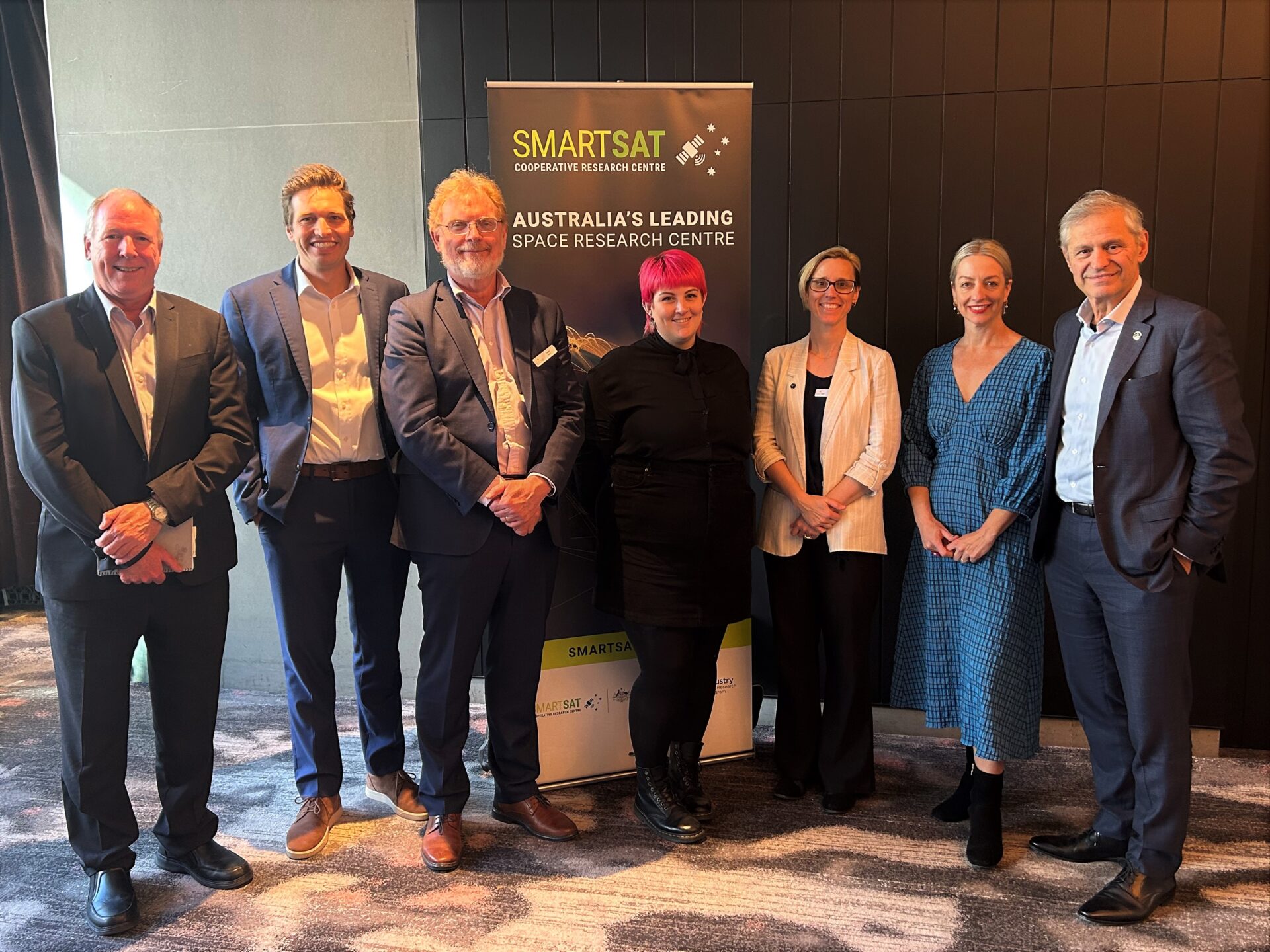This week SmartSat hosted the second Defence & National Security Showcase at the Hotel Realm in Canberra, welcoming key stakeholders from defence, the broader national security community and industry to receive an update on our relevant research projects and strategic direction. Over 70 people attend this half-day event that included a research project highlight session and the main Showcase event that provided a more strategic view of Defence interests in space technology and innovation and how SmartSat supports the national enterprise.
The research highlights session was chaired by Chief Research officer, Dr Carl Seubert, this session featured a selection of projects from our portfolio with actual or potential benefit to defence split into three categories: space domain awareness, AI in space, and advanced communications.
 Professor Andy Koronios, SmartSat CEO, presenting on the achievements of the CRC over the past four years
Professor Andy Koronios, SmartSat CEO, presenting on the achievements of the CRC over the past four years
SmartSat Professorial Chair of Sentient Satellites, Professor Tat-Jun Chin from University of Adelaide, kicked off the showcase with an overview of Project P2.36 Satellite Proximity Surveillance System (SatProx). This project to develop an intelligent payload to automatically detect, track and characterize encroaching satellites using maneuverable cameras and AI has potential to protect valuable space assets from interference or hijacking. Dr Sholto Forbes-Spyratos from CGI set the scene, presenting on ACTIVE Space Domain Awareness and the current endeavour to improve the responsiveness of the space domain awareness detection and decision cycle through efficient processing, decision-making and sensor tasking. Following on a similar theme, Professor Shannon Ryan from Deakin University gave an update on the findings from Project P2.50 SatPing – a tracking beacon for spacecraft. This small scoping study has identified multiple technology options for a self-sufficient payload system to be used for active, real-time onboard orbital knowledge.
The session on AI in space commenced with an overview on the SASAT1 mission satellite Kanyini and the work currently underway on integrating the hyperspectral imaging and IoT payloads. Dr Seubert, presenting on behalf of SmartSat Senior Satellite Engineer Nick Manser, outlined the potential defence use cases for the payloads, including image tasking and operations, and low bandwidth communication packets. This provided a good segue for the University of South Australia’s Dr Sha Lu presenting on Project P2.38 small satellite energy-efficient on-board AI processing of hyperspectral imagery for early fire-smoke detection. This research has an objective to deliver an energy-efficient solution for on-board processing of hyperspectral imagery to support the early detection of fire smoke, capability that could aid military response to bushfires. Tharindu Fernando from Queensland University of Technology rounded out the session with a review of Project P2.34 Onboard Hyperspectral AI: calibration, panoptic segmentation, fine-grained analysis, and joint space-ground inference. The new capabilities under development through this project aim to enhance the efficiency and effectiveness of data gathering and communication, as well as the inference of detailed information in areas not covered by ground-based sensors.
Turning the focus to advanced communications, Dr Jeewani Kodithuwakkuge from Defence Science and Technology (DSTG) presented research updates on Project P1.28 Inter-satellite links using millimeter waves. This project aims to develop a novel communication system for Inter-satellite links at millimetre wave frequencies that can be utilised by small satellites, which would significantly improve secure communications for military forces in the field. RMIT University’s Fernando Moya presented on Project P1.27 Cognitive Satellite Radios on behalf of project leader Professor Kandeepan Sithamparanathan. The focus of the research conducted a spart of this study is to provide greater insight into cognitive satellite radio technology for defence and commercial usage, based on radio environment sensing methods in satcom settings. Professor Stephen Hanly from Macquarie University followed this with an update on Project P1.30 integrated tactical communications, most notably how low earth orbit satellite networks have a use case for tactical operations due to their ability to support multiple data streams, including voice, low rate data, and remote sensors.
All of this research feeds back into the SmartSat Indo-Pacific Connector Capability Demonstrator, led by Defence & National Security Coordinator, Peter Kerr, who wrapped up this morning session with an outline for SmartSat’s future direction for supporting defence through future concepts for hybrid space architecture and building the national understanding and maturity of emerging space technologies.
 (Left to right) SmartSat staff Professor Craig Smith, Dr Carl Seubert, Peter Kerr, Madison White, Dr Sarah Cannard, Elizabeth Weeks and Professor Andy Koronios following the Defence & National Security Showcase
(Left to right) SmartSat staff Professor Craig Smith, Dr Carl Seubert, Peter Kerr, Madison White, Dr Sarah Cannard, Elizabeth Weeks and Professor Andy Koronios following the Defence & National Security Showcase
After a break for lunch, the showcase continued, led by Mr Albert Zehetner, DSTG’s Scientific Advisor for the Space Domain embedded within Defence Space Command. DSTG’s Space Program Lead, Dr Damian Hall, outlined for the room the integrated defence innovation, science and technology space program and its strategic aim to assure access to space for defence for warfighting effectiveness. The current mission of Defence Space Command is to prepare space power to secure Australia’s interests in peace and in war, a mission SmartSat hopes to continue to support through its comprehensive research portfolio and strong connections to industry, government, and academia. This was put into context for attendees in an update on SmartSat’s achievements and successes from CEO, Professor Andy Koronios. He handed over to Industry Director, Dr Sarah Cannard, for an overview on how SmartSat supports the technology developed through our research projects to meet the needs of industry and visa versa, focusing on projects that fill gaps existing within the sector. SmartSat Mike Miller Chair in Telecommunications, Professor Craig Smith, wrapped the day with a case study overview of technology development, specifically focused on optical communications and quantum technology, particularly those technologies already adding to defence’s capability, such as Project P1.19 Compact Hybrid Optical/RF User Segment (CHORUS), as showcased at the most recent Australian Space Forum, and Project P1.18 Coherent Free-Space Optical Communications which was recently involved in Exercise Talisman Sabre.
SmartSat CRC received a lot of positive feedback from attendees and will seek to further improve our understanding of which of our technologies are most likely to deliver high level impact across this critical sector. To find out more and view the presentations from the event, click here.